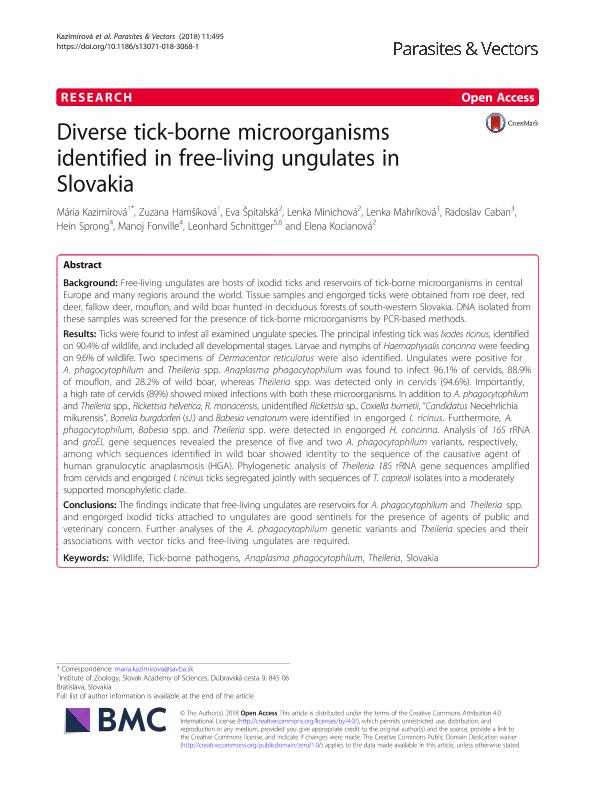Mostrar el registro sencillo del ítem
dc.contributor.author
Kazimírová, Mária
dc.contributor.author
Hamšíková, Zuzana
dc.contributor.author
Spitalská, Eva
dc.contributor.author
Minichová, Lenka
dc.contributor.author
Mahríková, Lenka
dc.contributor.author
Caban, Radoslav
dc.contributor.author
Sprong, Hein
dc.contributor.author
Fonville, Manoj
dc.contributor.author
Schnittger, Leonhard

dc.contributor.author
Kocianová, Elena
dc.date.available
2020-03-06T20:39:44Z
dc.date.issued
2018-09
dc.identifier.citation
Kazimírová, Mária; Hamšíková, Zuzana; Spitalská, Eva; Minichová, Lenka; Mahríková, Lenka; et al.; Diverse tick-borne microorganisms identified in free-living ungulates in Slovakia; BioMed Central; Parasites and Vectors; 11; 1; 9-2018; 1-18
dc.identifier.issn
1756-3305
dc.identifier.uri
http://hdl.handle.net/11336/98993
dc.description.abstract
Background: Free-living ungulates are hosts of ixodid ticks and reservoirs of tick-borne microorganisms in central Europe and many regions around the world. Tissue samples and engorged ticks were obtained from roe deer, red deer, fallow deer, mouflon, and wild boar hunted in deciduous forests of south-western Slovakia. DNA isolated from these samples was screened for the presence of tick-borne microorganisms by PCR-based methods. Results: Ticks were found to infest all examined ungulate species. The principal infesting tick was Ixodes ricinus, identified on 90.4% of wildlife, and included all developmental stages. Larvae and nymphs of Haemaphysalis concinna were feeding on 9.6% of wildlife. Two specimens of Dermacentor reticulatus were also identified. Ungulates were positive for A. phagocytophilum and Theileria spp. Anaplasma phagocytophilum was found to infect 96.1% of cervids, 88.9% of mouflon, and 28.2% of wild boar, whereas Theileria spp. was detected only in cervids (94.6%). Importantly, a high rate of cervids (89%) showed mixed infections with both these microorganisms. In addition to A. phagocytophilum and Theileria spp., Rickettsia helvetica, R. monacensis, unidentified Rickettsia sp., Coxiella burnetii, "Candidatus Neoehrlichia mikurensis", Borrelia burgdorferi (s.l.) and Babesia venatorum were identified in engorged I. ricinus. Furthermore, A. phagocytophilum, Babesia spp. and Theileria spp. were detected in engorged H. concinna. Analysis of 16S rRNA and groEL gene sequences revealed the presence of five and two A. phagocytophilum variants, respectively, among which sequences identified in wild boar showed identity to the sequence of the causative agent of human granulocytic anaplasmosis (HGA). Phylogenetic analysis of Theileria 18S rRNA gene sequences amplified from cervids and engorged I. ricinus ticks segregated jointly with sequences of T. capreoli isolates into a moderately supported monophyletic clade. Conclusions: The findings indicate that free-living ungulates are reservoirs for A. phagocytophilum and Theileria spp. and engorged ixodid ticks attached to ungulates are good sentinels for the presence of agents of public and veterinary concern. Further analyses of the A. phagocytophilum genetic variants and Theileria species and their associations with vector ticks and free-living ungulates are required.
dc.format
application/pdf
dc.language.iso
eng
dc.publisher
BioMed Central

dc.rights
info:eu-repo/semantics/openAccess
dc.rights.uri
https://creativecommons.org/licenses/by-nc-sa/2.5/ar/
dc.subject
ANAPLASMA PHAGOCYTOPHILUM
dc.subject
SLOVAKIA
dc.subject
THEILERIA
dc.subject
TICK-BORNE PATHOGENS
dc.subject
WILDLIFE
dc.subject.classification
Enfermedades Infecciosas

dc.subject.classification
Ciencias de la Salud

dc.subject.classification
CIENCIAS MÉDICAS Y DE LA SALUD

dc.title
Diverse tick-borne microorganisms identified in free-living ungulates in Slovakia
dc.type
info:eu-repo/semantics/article
dc.type
info:ar-repo/semantics/artículo
dc.type
info:eu-repo/semantics/publishedVersion
dc.date.updated
2020-02-18T16:09:51Z
dc.journal.volume
11
dc.journal.number
1
dc.journal.pagination
1-18
dc.journal.pais
Reino Unido

dc.journal.ciudad
Londres
dc.description.fil
Fil: Kazimírová, Mária. Slovak Academy of Sciences. Institute of Zoology; Eslovaquia
dc.description.fil
Fil: Hamšíková, Zuzana. Slovak Academy of Sciences. Institute of Zoology; Eslovaquia
dc.description.fil
Fil: Spitalská, Eva. Slovak Academy of Sciences. Institute of Virology. Biomedical Research Center,; Eslovaquia
dc.description.fil
Fil: Minichová, Lenka. Slovak Academy of Sciences. Institute of Virology. Biomedical Research Center,; Eslovaquia
dc.description.fil
Fil: Mahríková, Lenka. Slovak Academy of Sciences. Institute of Zoology; Eslovaquia
dc.description.fil
Fil: Caban, Radoslav. Široká ; Eslovaquia
dc.description.fil
Fil: Sprong, Hein. National Institute for Public Health and Environment.Laboratory for Zoonoses and Environmental Microbiology; Países Bajos
dc.description.fil
Fil: Fonville, Manoj. National Institute for Public Health and Environment.Laboratory for Zoonoses and Environmental Microbiology; Países Bajos
dc.description.fil
Fil: Schnittger, Leonhard. Instituto Nacional de Tecnología Agropecuaria. Centro de Investigación en Ciencias Veterinarias y Agronómicas. Instituto de Patobiología; Argentina. Consejo Nacional de Investigaciones Científicas y Técnicas; Argentina
dc.description.fil
Fil: Kocianová, Elena. Slovak Academy of Sciences. Institute of Virology. Biomedical Research Center,; Eslovaquia
dc.journal.title
Parasites and Vectors

dc.relation.alternativeid
info:eu-repo/semantics/altIdentifier/doi/http://dx.doi.org/10.1186/s13071-018-3068-1
dc.relation.alternativeid
info:eu-repo/semantics/altIdentifier/url/https://parasitesandvectors.biomedcentral.com/articles/10.1186/s13071-018-3068-1
Archivos asociados
